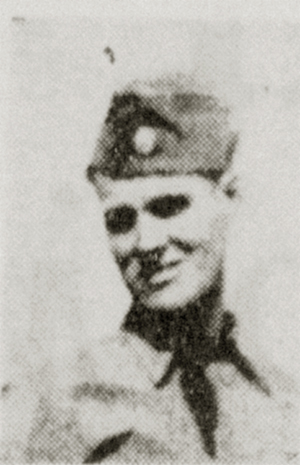

Remember...
Bow Smith
1915-1945
"Today we may say aloud before an awe-struck world: ‘We are still masters of our fate. We are still captain of our souls."
Prime Minister Winston Churchill
Private First Class Bow Smith was born June 15, 1915, in Mount Hope, Fayette County, West Virginia, to George A. and Bessie Lynn Smith. His siblings included James Gordon, Thelma (married name: Stover), Woodie, Lucian, and Ted. When Bow registered for the draft on October 6, 1940, at Fayetteville, he indicated that he was unemployed. However, when he enlisted in the U.S. Army on January 20, 1941, at Huntington, West Virginia, he stated that his civilian occupation was that of bartender. His enlistment record shows that he was single, without dependents, and had a grammar school education.
Bow Smith was assigned to the 94th Field Artillery Battalion, 4th Armored Division. The unit exhibited a highly distinguished record in World War II. The U.S. Army 94th Field Artillery Regiment, first constituted in 1933, served with the 4th Armored Division, where it became the 94th Field Artillery Battalion in January 1942. On January 6, 1942, it was assigned to the 4th Armored Division and activated at Pine Camp, New York. Its participation included Normandy, Northern France, Rhineland, Ardennes-Alsace, and Central Europe.
The 4th was an armored division of the United States Army that earned distinction while spearheading General Patton's Third Army in the European Theater of World War II. The Division was activated during World War II on April 15, 1941, with 3,800 men (10,000 by the end of May 1941) from various other units at Pine Camp, New York. The Division was organized as a full armored division in May and June 1942. It left Pine Camp for Camp Forrest for the Tennessee maneuvers in the Cumberland Mountains held in September and October. In mid-November, it was transferred to the Camp Ibis Desert Training Center in the California-Arizona maneuver area. On June 3 [1943], the 4th Armored Division arrived at Camp Bowie, Texas, for more maneuvers until December, when it departed for Camp Myles Standish in Massachusetts for winter training. On December 29, the Division departed Boston to conduct training in England for the invasion of Normandy.
After training in England from January to July 1944, the 4th Armored Division landed at Utah Beach on July 11, over a month after the initial Normandy landings, and first entered combat on July 17; on July 28, it secured the Coutances area. The Division then swung south to take Nantes, cutting off the Brittany Peninsula, on August 12. Turning east, it drove swiftly across France north of the Loire. The 4th fought several German panzergrenadier brigades in the Lorraine area, defeating a larger German force through superior tactics and training. During the fall, it was engaged in a number of operations throughout northern France.
In the middle of December, the Germans launched their Ardennes Offensive, what was to be commonly known as the Battle of the Bulge. The 4th Armored Division, spearheading Patton's Third Army, attacked the Germans at Bastogne and, on December 26, became the first unit to break through at Bastogne and relieved the 101st Airborne Division. Six weeks later, the 4th jumped off from Luxembourg City in an eastward plunge that carried it across the Moselle River at Trier, south, and east to Worms, and across the Rhine on March 24 and 25. Advancing all night, the Division crossed the Main River the next day, south of Hanau, and continued to push on. Lauterbach fell on March 29, Creuzburg across the Werra on April 1, and Gotha on April 4, where the Division liberated the Ohrdruf concentration camp, the first Nazi camp liberated by U.S. troops. ("4th Armored Division," Wikipedia, last edited 3 March 2021, accessed 19 March 2021, https://en.wikipedia.org/wiki/4th_Armored_Division_(United_States).) It is to this last series of operations we must turn our attention, for this is where Pfc. Bow Smith was highly engaged in the action that cost him his life.
Pfc. Bow Smith's name shows up in the U.S. World War II Hospital Admission Card Files, 1942-1954, three times. His first battle injury was an artillery shell to the breast. He was admitted to the hospital in August 1944 and discharged in September 1944. His second injury, an artillery shell to the wrist, occurred in October 1944, and he was discharged that same month. Then in March 1945 he sustained a fatal injury. He was killed in action on March 29 in the vicinity of Lauterbach, Germany.
Article prepared by Patricia Richards McClure
March 2021

West Virginia Archives and History welcomes any additional information that can be provided about these veterans, including photographs, family names, letters and other relevant personal history.